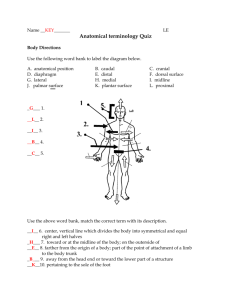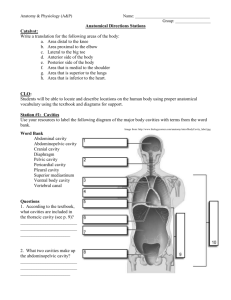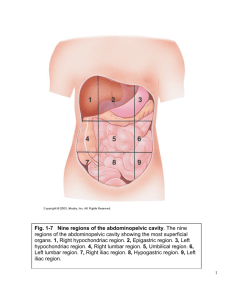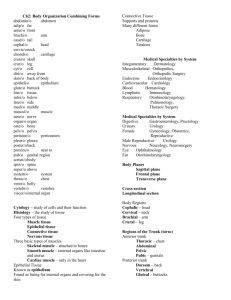Surface Anatomy - halkuffanatomy
advertisement
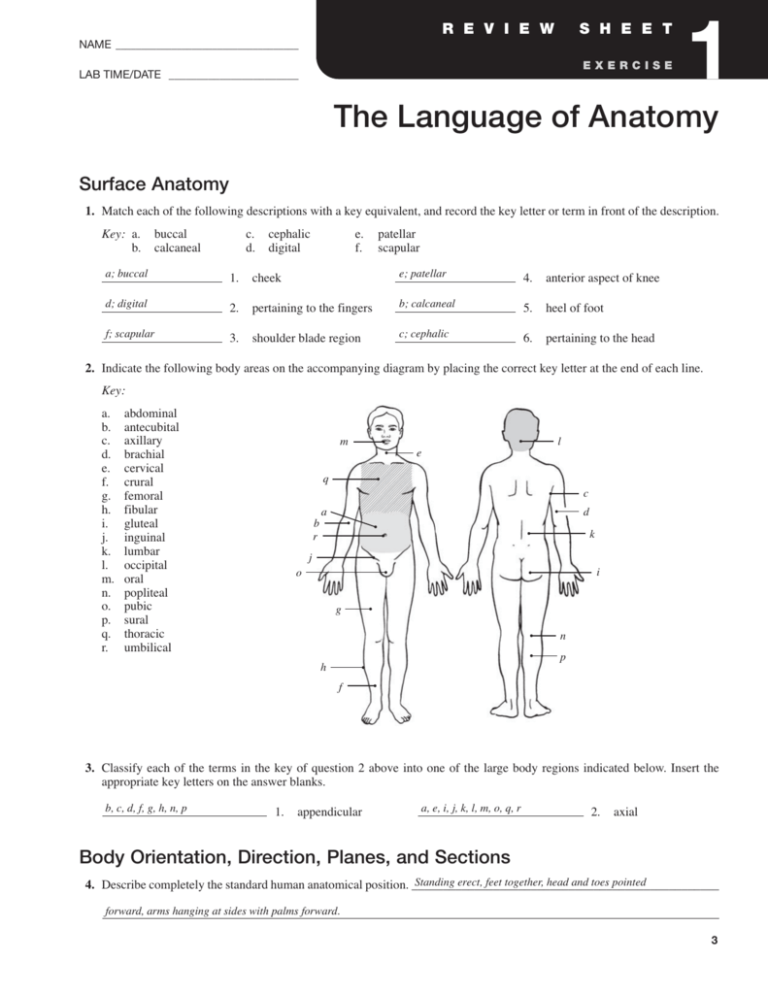
R E V I E W S H E E T NAME ____________________________________ EXERCISE LAB TIME/DATE _______________________ 1 The Language of Anatomy Surface Anatomy 1. Match each of the following descriptions with a key equivalent, and record the key letter or term in front of the description. Key: a. b. buccal calcaneal c. d. cephalic digital e. f. patellar scapular a; buccal 1. cheek e; patellar 4. anterior aspect of knee d; digital 2. pertaining to the fingers b; calcaneal 5. heel of foot f; scapular 3. shoulder blade region c; cephalic 6. pertaining to the head 2. Indicate the following body areas on the accompanying diagram by placing the correct key letter at the end of each line. Key: a. b. c. d. e. f. g. h. i. j. k. l. m. n. o. p. q. r. abdominal antecubital axillary brachial cervical crural femoral fibular gluteal inguinal lumbar occipital oral popliteal pubic sural thoracic umbilical m l e q c a d b r k j i o g n p h f 3. Classify each of the terms in the key of question 2 above into one of the large body regions indicated below. Insert the appropriate key letters on the answer blanks. b, c, d, f, g, h, n, p 1. appendicular a, e, i, j, k, l, m, o, q, r 2. axial Body Orientation, Direction, Planes, and Sections Standing erect, feet together, head and toes pointed 4. Describe completely the standard human anatomical position. _________________________________________________ forward, arms hanging at sides with palms forward. 3 A cut along an imaginary plane through the body wall or organ. 5. Define section. ______________________________________________________________________________________ 6. Several incomplete statements are listed below. Correctly complete each statement by choosing the appropriate anatomical term from the key. Record the key letters and/or terms on the correspondingly numbered blanks below. Key: a. b. c. anterior distal frontal d. e. f. inferior lateral medial g. h. i. posterior proximal sagittal j. k. superior transverse In the anatomical position, the face and palms are on the _1_ body surface; the buttocks and shoulder blades are on the __2_ body surface; and the top of the head is the most _3_ part of the body. The ears are _4_ and _5_ to the shoulders and _6_ to the nose. The heart is _7_ to the vertebral column (spine) and _8_ to the lungs. The elbow is _9_ to the fingers but _10_ to the shoulder. The abdominopelvic cavity is _11_ to the thoracic cavity and _12_ to the spinal cavity. In humans, the dorsal surface can also be called the _13_ surface; however, in quadruped animals, the dorsal surface is the _14_ surface. If an incision cuts the heart into right and left parts, the section is a _15_ section; but if the heart is cut so that superior and inferior portions result, the section is a _16_ section. You are told to cut a dissection animal along two planes so that both kidneys are observable in each section. The two sections that will always meet this requirement are the _17_ and _18_ sections. A section that demonstrates the continuity between the spinal and cranial cavities is a _19_ section. 1. a; anterior 8. f; medial 14. j; superior 2. g; posterior 9. h; proximal 15. i; sagittal 3. j; superior 10. b; distal 16. k; transverse 4. f; medial 11. d; inferior 17. c; frontal 5. j; superior 12. a; anterior 18. k; transverse 6. e; lateral 13. g; posterior 19. i; sagittal 7. a; anterior 7. Correctly identify each of the body planes by inserting the appropriate term for each on the answer line below the drawing. (a) median (mid-sagittal) plane 4 Review Sheet 1 (b) frontal plane (c) transverse plane 8. Draw a kidney as it appears when sectioned in each of the three different planes. sagittal section frontal section transverse section 9. Correctly identify each of the nine areas of the abdominal surface by inserting the appropriate term for each of the letters indicated in the drawing. a. epigastric region b. right hypochondriac region c. left hypochondriac region d. umbilical region e. right lumbar region f. left lumbar region g. hypogastric (pubic) region h. right iliac reigon i. left iliac region (a) (b) (c) (d) (e) (f) (g) (h) (i) Body Cavities 10. Which body cavity would have to be opened for the following types of surgery or procedures? (Insert letter of key choice in same-numbered blank. More than one choice may apply.) Key: a. b. abdominopelvic cranial c. d. dorsal spinal e. f. thoracic ventral e, f 1. surgery to remove a cancerous lung lobe a, f 4. appendectomy a, f 2. removal of the uterus, or womb a, f 5. stomach ulcer operation b, c 3. removal of a brain tumor d, c 6. delivery of pre-operative “saddle” anesthesia Review Sheet 1 5 diaphragm 11. Name the muscle that subdivides the ventral body cavity. ____________________________________________________ Skeletal, muscular, integumentary 12. Which organ system would not be represented in any of the body cavities? _______________________________________ Dorsally, the vertebral column; laterally and anteriorly, 13. What are the bony landmarks of the abdominopelvic cavity? __________________________________________________ the pelvis ___________________________________________________________________________________________________ Abdominal 14. Which body cavity affords the least protection to its internal structures? _________________________________________ The serous membranes produce a lubricating fluid (serous 15. What is the function of the serous membranes of the body? ___________________________________________________ fluid) that reduces friction as organs slide across one another or against the cavity walls during their functioning. __________________________________________________________________________________________________ 16. Using the key choices, identify the small body cavities described below. Key: a. b. middle ear cavity nasal cavity c. oral cavity d. orbital cavity e. synovial cavity d; orbital cavity _________________ 1. holds the eyes in an anterior-facing position c; oral cavity ________________ 4. contains the tongue a; middle ear cavity _________________ 2. houses three tiny bones involved in hearing e; synovial cavity ________________ 5. lines a joint cavity b; nasal cavity _________________ 3. contained within the nose 17. On the incomplete flowchart provided below: • Fill in the cavity names as appropriate to boxes 3–8. • Then, using either the name of the cavity or the box numbers, identify the descriptions in the list that follows. Body cavities 1 Dorsal body cavity 3 cranial cavity (superior) 4 vertebral/spinal cavity (inferior) 2 Ventral body cavity 5 thoracic 6 abdominopelvic cavity (inferior) cavity (superior) 7 abdominal cavity (superior) 1 6 a. contained within the skull and vertebral column 8 b. houses female reproductive organs 1, 3, 4 c. the most protective body cavity 2 d. its name means belly Review Sheet 1 8 pelvic cavity (inferior) 5 e. contains the heart 6 or 7 f. contains the small intestine 5 g. bounded by the ribs 6 or 7 h. its walls are muscular



